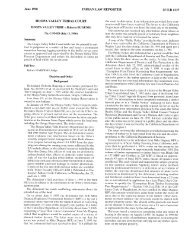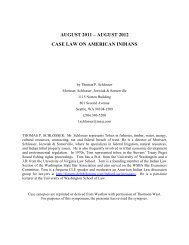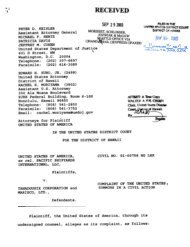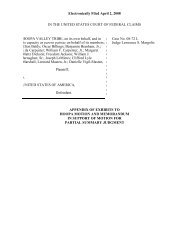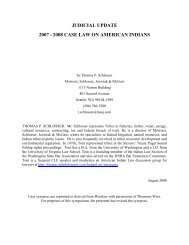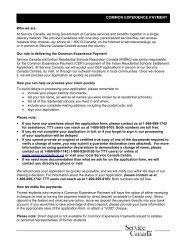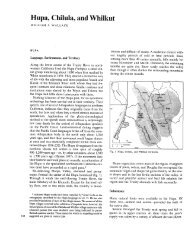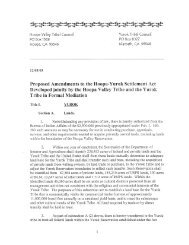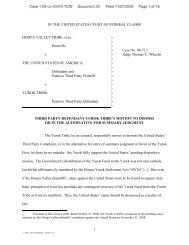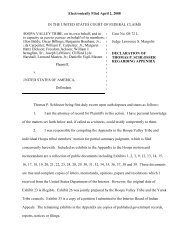Create successful ePaper yourself
Turn your PDF publications into a flip-book with our unique Google optimized e-Paper software.
21a1 recognition that such tribes or any other Indian tribe may havevested rights in the lands and resources of the joint reservation. InHynes v. Grimes Packing Co., 337 U.S. 86 (19491, the Supreme Courtheld that an executive order reservation “conveys no right of use ofoccupancy to the beneficiaries beyond the pleasure of Congress orthe President.” Subsequent cases establish that the compensableright of a tribe in an executive order reservation depends upon itsstatus as a confirmed or unconfirmed reservation. The exact legalstatus of the reservation is unclear from the various Federal courtdecisions relating to it. However, the decisions of the Court ofClaims in the Short case and the Direct Court in the Puzz casemake clear that no existing Indian tribe as a tribe, including theHoopa and Yurok tribes, have a vested right in the asset and resourcesof the Hoopa Valley Reservation as now constituted.Subsection (b) provides that, effective with the partition as providedin subsection (a), that portion of the reservation known asthe “Square” shall be recognized as the Hoopa Valley Reservationand shall be a reservation for the Hoopa Valley Tribe. The Committeenotes that, while the record before the Committee and thefindings of the court in the Short cases show that the “Square” includedaboriginal lands of the Yurok or Klamath Indians, most ofthe lands of the “Square” were within the aboriginal territory ofthe Hoopa and related bands and villages.Subsection (c), paragraph (l), provides that, effective with thepartition as provided in subsection (a), that portion of the reservationknown as the “extension”, excluding the lands of the ResighiniRancheria, shall be recognized as the Yurok Reservation and shallbe a reservation for the Yurok Tribe. The Committee again notesthat the lands comprising the new Yurok reservation were withinthe aboriginal lands of the Yurok or Klamath bands or villages.Paragraph (2) provides that, subject to all valid existing rights,all national forest lands in the Yurok Reservation and about 14acres of the Yurok Experimental Forest shall be transferred to theYurok Tribe in trust.Paragraph (3) provides that the existing authority of the Secretaryto acquire lands for Indians and Indian tribes under theIndian Reorganization Act of 1934 shall be applicable to the YurokTribe; $5,000,000 is authorized to be appropriated for land acquisitionfor the Yurok Tribe with the limitation that such funds can beused to acquire lands outside the reservation only for purposes ofexchange for lands inside. The Committee expects that the Secretarywould make use of this and other authority to insure thatIndian lands within the reservation are not, or do not become,landlocked.Paragraph (4) provides that (1) the transfer of funds to the YurokTribe under sections 4 and 7; (2) the land transfer under subsection2(~)(2); (3) the land acquisition authority of section 2(c)(3); and (4)the organizational authorities for the Yurok Tribe under section 9shall not be effective unless the general council of the Yurok Tribeadopts a resolution waiving any claims it might have against theUnited States under this Act as provided in section S(c)(Z)(A).Subsection (d) provides that that boundary line between theHoopa Valley and Yurok reservations, as partitioned in this section,shall be the line established by the Bissel-Smith survey and



